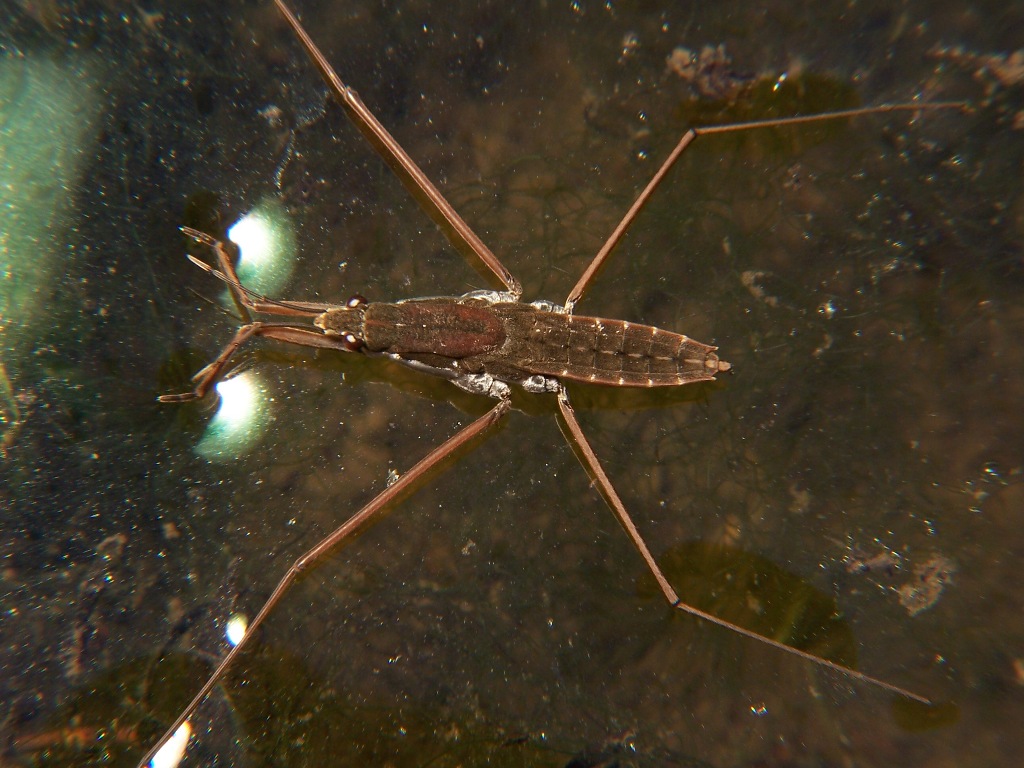- Gerridae
image_width = 250px
image_caption = Adult Water Strider "Gerris remigis "
regnum =Animal ia
phylum =Arthropod a
classis =Insect a
ordo =Hemiptera
subordo =Heteroptera
infraordo =Gerromorpha
familia = Gerridae
familia_authority = Leach, 1815
subdivision_ranks = Genera
subdivision = "Aquarius" "Eotrechus " "Gerris " "Halobates " "Limnogonus " "Limnoporus " "Metrobates " "Neogerris " "Rheumatobates " "Trepobates "The family Gerridae contains insects commonly known as water striders, water bugs, magic bugs, pond skaters, skaters, skimmers, water scooters, water skaters, water skeeters, water skimmers or water skippers. These are predatory
insect s which rely onsurface tension to walk on top ofwater . They live on the surface of ponds, slow streams, marshes, and other quiet waters. They can move very quickly, up to 1.5 m/s."Five species of Halobates sea skaters are the only insects that have successfully colonized open ocean habitats. [...] H. micans populations from the Pacific, Atlantic and Indian Oceans have been isolated for 1 to 3 million years". [ [http://esa.confex.com/esa/2001/techprogram/paper_173.htm Molecular genetics and distribution of the ocean-skater Halobates (Heteroptera: Gerridae)] ]
Propulsion method
Animals such as water striders that live on the surface of water need to push something backwards to generate a reaction force (that is, ).
It was originally thought that water striders transferred
momentum to the water by the creation ofcapillary waves on the surface. However, biophysicistMark Denny showed that to do this, some object must move faster than about 0.25 m/s—far faster than a water strider can move its legs. This apparent contradiction is known asDenny's paradox .Water striders beat Denny's paradox by generating not capillary waves but hemispherical vortices in the water. These vortices carry sufficient backwards momentum to propel the animal forwards.
In a series of experiments,
mathematician John W. M. Bush and several graduate students showed that during the rowing stroke, water striders drive their middle legs backwards without penetrating the surface, and can attain speeds of up to 1.5 m/s.Besides skating on the surface of water, most adult water striders can also use wings (e.g. to fly to another body of water). In many species the presence or absence of wings in the adults is a
polymorphism ; that is, only at certain times of year, or under certain conditions, do adults develop wings in order to disperse, while at other times, they conserve their developmental resources and develop as wingless adults. [http://www.discoverlife.org/mp/20o?search=Gerridae]Nature of the hydrophobic legs
Water striders can stand effortlessly on water due to their non-wetting legs. Writing in Nature, biophysicists
Xuefeng Gao andLei Jiang show that the water resistance of the legs is due to the "special hierarchical structure of the legs, which are covered by large numbers of oriented tinyhair s (microsetae) with fine nanogrooves". They go on to demonstrate that the water resistance is due more to this physical structure than the chemical properties of thewax coating of the legs.Gao and Jiang calculate the maximal supporting force of a single leg to be is 1.52 millinewtons (152
dyne s or 0.011poundal ), which is about 15 times the total body weight of the insect. This shows that the surface of the leg is strikingly water repellent.For comparison, Gao and Jiang made a
hydrophobic 'leg' from a smoothquartz fibre that was similar in shape and size to a strider's leg. Its surface was coated with a thin layer ofheptadecafluorodecyltrimethoxysilane (FAS-17), whosecontact angle withwater is 109°. However, this artificial leg supported a force of only 0.19 mN (19 dyn or 0.0014 pdl): this would be just about enough to support the strider at rest, but not to enable it to dart around rapidly on the surface.Gao and Jiang went on to calculate that the contact angle with water on a real strider's leg would be greater than 150° (and described this using the
neologism 'superhydrophobic ') and, using a sessile water-drop showed that the contact angle of the insect's legs with water was 167.6° ± 4.4°.They went on to infer that the observed superhydrophobicity was due to microstructures on the legs and, using a
scanning electron microscope , showed that the legs were covered in many needle shapedseta e, with diameters ranging from 3micrometre s down to a few hundrednanometre s. Most of the setae were about 50 micrometres long and were at an angle of about 20° from the surface of leg. Each microseta also had nanoscale grooves, contributing to the hierarchical structure of the leg.Gao and Jiang used
Cassie's law to show thatair is trapped in spaces in the microsetae and nanogrooves, forming a cushion at the leg–water interface. This cushion prevents the legs from being wetted.ee also
*
Veliidae (Smaller water strider)
*Animal locomotion on the surface layer of water ources and notes
*
Further reading
* [http://cirrusimage.com/bugs_water_strider.htm Large format pictures: winged and wingless varieties]
* [http://www.washingtonpost.com/ac2/wp-dyn?pagename=article&contentId=A26207-2003Aug6¬Found=true Row, Row, Row Your Bug]
Wikimedia Foundation. 2010.

